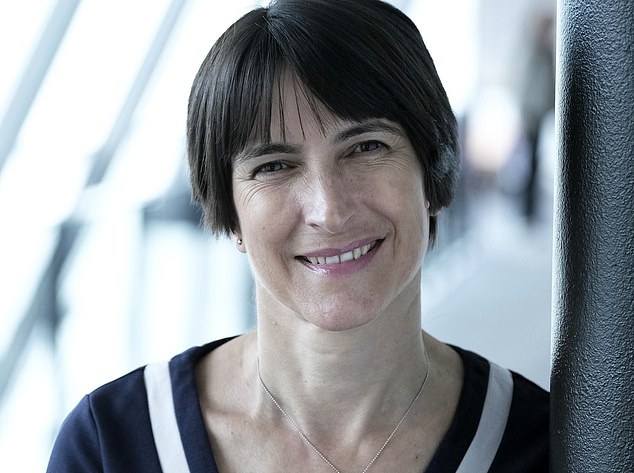Can having your pudding FIRST stop you from overeating? That’s just one example of the food order theories that are now taking social media by storm
Could the order in which you eat certain foods – rather than the quantity – be the key to staying slim and healthy?
That’s the claim behind the latest TikTok diet craze known as “food sequencing,” where wellness influencers share videos of themselves eating a bowl of salad or veggies for dinner, or nibbling a handful of protein-rich nuts for a carb-loaded meal (e.g. rice or pasta).
They claim that separating food groups and eating them in a certain order can help you cut out unnecessary snacking, lose weight – and even reduce symptoms of conditions such as polycystic ovary syndrome or PCOS, in which hormonal disruption causes weight gain, irregular periods and causes excessive hair. and poor blood sugar control.
But is there any science to support these claims?
Researchers from Imperial College London found that eating a sugary dessert first led people to eat less at the next meal

Research by dietitian Clare Thornton-Woodome has found that food sequencing can reduce overall calorie intake
There’s actually nothing new about the idea that eating foods in a certain order might be beneficial. In fact, sequencing formed the basis of the Hay diet – invented by American doctor Dr William Hay in the 1920s and which became popular again in the 1990s when a wave of celebrities, including Elizabeth Hurley, revealed they were following it.
Hay encouraged people never to eat carbohydrates and protein at the same meal, but to separate them by several hours and eat only fruit for breakfast, claiming this would prevent digestive problems and promote general health.
Hay’s diet was based on the idea that some foods were alkaline and others were acidic and that the two should never mix. Although science has debunked these theories, could Hay be on to something and not realize why?
‘Some research has shown that food sequencing can reduce overall calorie intake,’ says dietitian Clare Thornton-Wood from Guildford.
Researchers first showed this 20 years ago – a 2004 study from Pennsylvania State University in the US found that when people ate a salad starter before their main meal, they ate about 12 percent fewer calories overall, while research a 2007 study by the same researchers found that The university found that eating a bowl of thick vegetable soup first reduced total calorie intake by 20 percent.
More recently, researchers at Imperial College London found that eating a sugary dessert first led people to eat less at the next meal. The 2014 study specifically looked at a brain protein called glucokinase, which keeps track of how much sugar is eaten. Since sugar is the brain’s main fuel source, this protein will tell the body to need more if intake is too low.
So, in theory, by eating sugary foods first, the brain quickly determines that enough has been eaten, allowing other body systems that control appetite to kick in and keep us from overeating. While if sugary foods are eaten in smaller quantities during or after a meal (as is usually the case with dessert), the satiety trigger is activated later and you end up eating more.
“It’s an interesting study, but based on that I wouldn’t recommend eating pudding first,” says Clare Thornton-Wood. too full to eat their main meal, missing out on essential nutrients such as protein, and the fiber and vitamins found in vegetables. Eating a lot of sugary foods can also just make some people crave more, because it activates important pleasure centers in the brain.”
But in addition to suppressing appetite, the supposed benefits of food sequencing, such as that proposed on TikTok, are often attributed to its effect on your blood sugar levels – stable blood sugar levels are linked to reduced food cravings, reduced weight gain and, in the long term, a lower risk of type 2 diabetes and heart disease.
The logic here is that foods cause a more dramatic spike in blood sugar depending on which food comes before or after – and there is some research to support this.
A 2018 study at Kanazawa University in Japan found that eating protein (in the form of meat) or vegetables before rice could reduce blood sugar levels. The participants who ate rice at the end of the meal had a significantly lower increase in blood sugar and insulin levels 30 minutes later than those who consumed rice first.
“What we call ‘preload’ studies, where people are given a particular nutrient or food up to 30 minutes before a meal, show that consuming protein, fat or fiber before a high-carb meal can reduce glucose spikes,” says Professor Sarah Berry , a nutrition scientist at King’s College London and lead scientist at Zoe, the nutrition app, who has led research into the effects of different foods on blood sugar levels.
‘This is because they slow down stomach emptying (how quickly food is digested) and also because proteins stimulate the release of insulin, meaning that when the carbohydrates enter the bloodstream they are removed more quickly, reducing the blood sugar response. ‘
So should we all eat some protein, fat or vegetables before eating something high in carbohydrates, such as pasta or rice? ‘In general, having a high-protein or high-fibre preload before consuming a high-carb meal means you will experience fewer blood sugar spikes,’ says Professor Berry. ‘And this better blood sugar control could potentially benefit metabolic conditions such as PCOS and prediabetes. But more importantly, this doesn’t happen for everyone and not in every study, so it’s not a one-size-fits-all strategy,” she continues.
And what about the studies showing that continental consumption of salad or soup before the main meal can reduce your overall calorie intake? ‘Salads and soups are generally high in fibre, which is bulky and can make you feel full, so when your main meal arrives you are likely to be less hungry and eat a little less,’ says Professor Berry.

Salads and soups are generally high in fiber, which is bulky and can make you feel full if you eat them first
‘We also know that high-fiber foods slow the speed at which food moves through your intestines, which in turn slows the absorption of glucose into your blood, decreasing your blood sugar response after eating.’
And there is some evidence that food sequencing may be useful if someone has a medical need to improve blood sugar control.
In a small 2023 study of 40 people whose blood sugar levels classified them as at risk for diabetes (prediabetes), half were advised to eat the carbohydrate portion of their meal last – after proteins and vegetables – for 16 weeks. compared to standard healthy eating advice. While both groups lost weight and improved their blood sugar levels, the low-carb group significantly increased their vegetable intake and also found this approach easier to maintain – and were more likely to say they would continue eating this way.
The researchers, writing in the journal Nutrients, suggested that this approach could be more practical for people with prediabetes than, for example, low-carb diets, which can be difficult to maintain.
‘But it’s also important to remember that micro-managing glucose spikes through food sequencing is simply not necessary for most of us and will only have a small impact on blood sugar levels,’ adds Professor Berry.
‘We don’t want to pathologize a glucose increase after a meal. It’s normal. Our body is well equipped to deal with it. We should focus more on the balance of good nutrition in a meal rather than the order in which we eat them.’
Dietitian Clare Thornton-Wood agrees: ‘Rather than carefully separating and organizing different foods – which can be triggering for people with eating disorders – it’s much more important to get decent amounts of all the major food groups.
‘Aim for at least five portions of fruit and vegetables per day, a protein source at every meal, a portion of carbohydrates (preferably whole grain) and three portions of dairy or plant-based fortified alternatives per day and you’ll be giving your body the best ingredients for a healthy diet. gain weight and keep yourself fit and healthy.’
